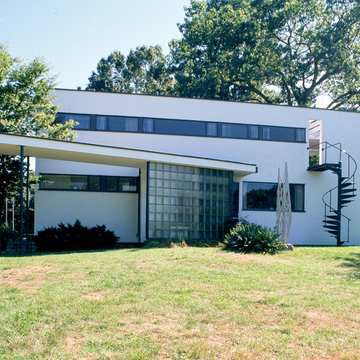Lincoln boasts the most important group of modernist houses in the Boston area. Through the generosity of Helen Storrow, a philanthropist who owned the land and financed the buildings, architects Walter Gropius, Marcel Breuer, Walter Bogner, and Constance Warren created a unique residential neighborhood. The appointment at Harvard in 1937 of architects Gropius and Breuer from the Bauhaus in Germany introduced International Style modernist design to that institution. Gropius designed his own house at 68 Baker Bridge Road (adjacent to Woods Ends Road, NHL) in 1938 as a New England accommodation of modernist principles. The horizontal flat-roofed box is covered with white flush boarding interrupted by horizontal bands of windows set in aluminum frames. A diagonally projecting covered walkway leads to the entrance on the left, counterpointed by a cast-iron circular staircase on the right front corner. A screened porch extending behind the dining room and a sundeck on the second floor rear open the house to the surrounding environment of pastureland and orchards. The light-filled interiors include an entrance hall with traditional New England clapboarding laid vertically. Still furnished with Gropius's modern furniture, the house is now owned and administered by the Society for the Preservation of New England Antiquities (now Historic New England, Inc.).
Marcel Breuer designed a bachelor residence for himself (1939, 5 Woods End Road) in a similar pattern of vertical flush boarding painted white, ribbon windows, and a flat


